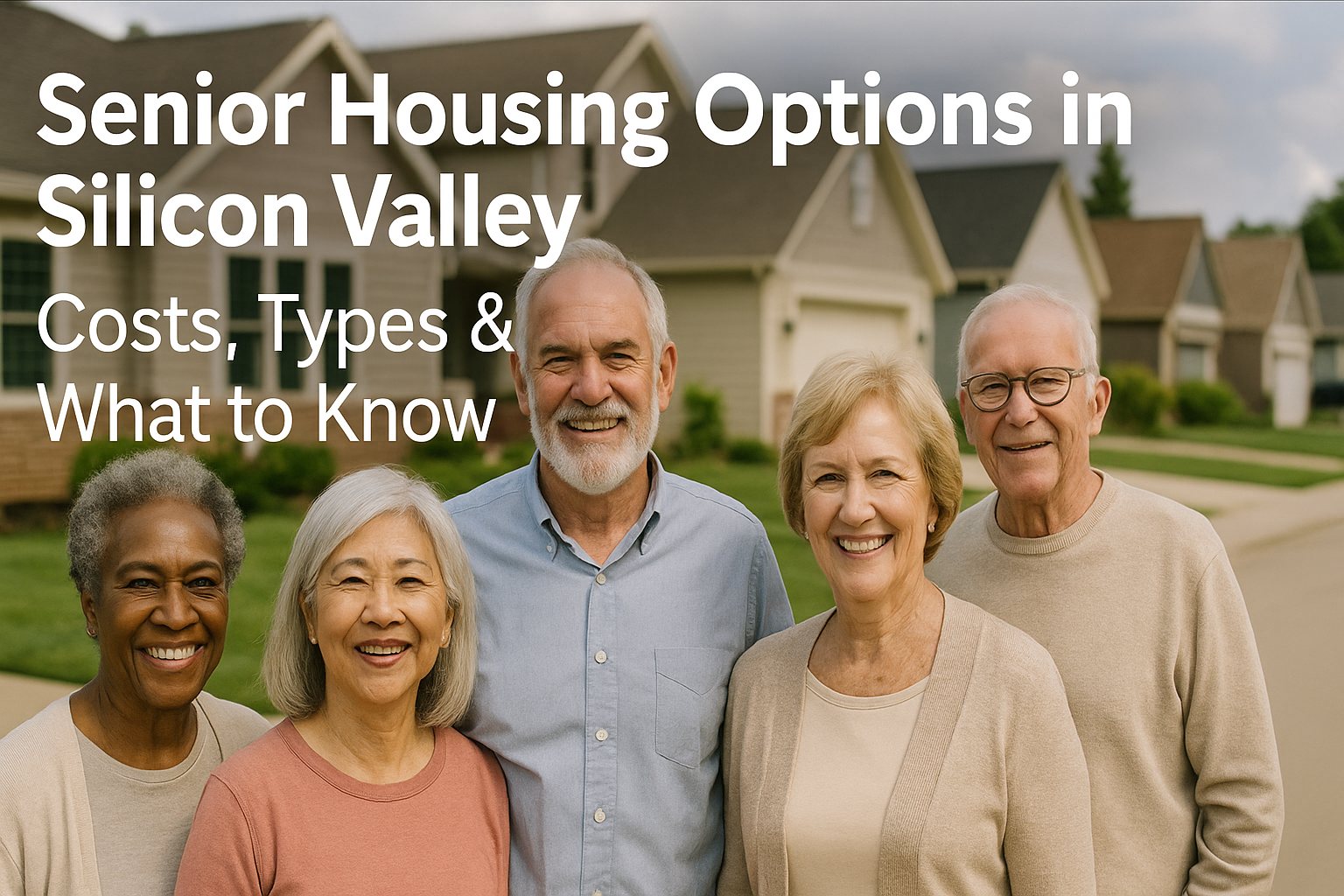Silicon Valley offers a broad range of senior housing options – from staying in one’s long-time home to living in specialized care facilities. Choosing the right option can depend on a senior’s health, independence level, lifestyle preferences, and budget. In a region known for its high cost of living, it’s especially important to understand what each housing type offers and how much it may cost. This guide will explain the different types of senior housing available across the Silicon Valley region, including who each option is best suited for and typical local costs.
Table of Contents
- Aging in Place
- Active Adult Communities
- Senior Co-Housing
- Independent Living Communities
- Assisted Living Facilities
- Residential Care Homes
- Memory Care Facilities
- Nursing Homes (Skilled Nursing Facilities)
- Affordable Senior Housing
- Summary of Options
Aging in Place (Staying at Home)
Many older adults choose to remain in their own homes for as long as possible, a choice often referred to as aging in place. Aging in place means continuing to live in your current residence, with or without modifications or in-home support, instead of moving to a senior-specific community. This might involve making home modifications (like installing grab bars or stair lifts) and hiring in-home caregivers or using family support to assist with daily needs. Thanks to California’s Proposition 13, some long-term homeowners enjoy very low property taxes, which can make remaining at home financially feasible . In fact, a strong majority of adults 50+ (about 75%) express the wish to stay in their homes as they age, highlighting how popular this option is.
- Who it’s best suited for: Seniors who are relatively independent and wish to maintain autonomy. This option is ideal for those who have a safe, accessible home (or can modify it for accessibility) and a support network for help when needed. It suits individuals who value familiar surroundings and routines. Aging in place can work well if one’s health needs are minimal or can be met by periodic in-home care (from family members or professional caregivers).
- Typical cost in Silicon Valley: The costs can vary widely. Living at home involves regular home expenses (taxes, utilities, maintenance) plus any additional help required. In-home care services in Silicon Valley average around $7,100 per month for about 44 hours of help per week . (This equates to roughly $35–$50 per hour for home health aides or homemaker services.) Costs can be lower if only a few hours of help are needed each week, or much higher if full-time or 24/7 in-home care is required. Seniors may also need to budget for one-time home modification costs – for example, installing a stair lift can range from a few thousand dollars and up . Overall, aging in place can be affordable for those with paid-off homes and minimal care needs , but for those requiring extensive caregiving, in-home assistance expenses can add up comparable to facility care.
Active Adult Communities (55+ Communities)
(back to top)
Active adult communities are housing developments restricted to residents above a certain age (often 55, 60 or 62), offering a lifestyle geared toward independent, active seniors. These are also known as 55+ communities or retirement communities. They typically consist of houses, condos, or apartments where all residents are older adults. Amenities are a big draw – many such communities feature recreation centers, pools, fitness facilities, golf courses, clubs and social events. For example, The Villages Golf & Country Club in San Jose is a 55+ gated community that offers resort-style living with an 18-hole golf course, tennis courts, swimming pools, fitness centers, and hundreds of acres of open space and trails . Unlike assisted living or nursing homes, these communities do not provide personal care or medical services – they are designed for independent living with a focus on leisure, recreation, and a sense of community.
- Who it’s best suited for: Healthy, independent seniors (usually in their 60s or above) who want an active, social lifestyle and the camaraderie of neighbors in their age group. It’s ideal for older adults who don’t need assistance with daily activities or healthcare supervision, but who appreciate conveniences like on-site activities, maintenance-free living (many such communities handle landscaping or exterior upkeep), and security of a gated or managed neighborhood. These communities often appeal to retirees looking for a vibrant social life – there are usually clubs, group outings, hobby workshops, and opportunities to meet like-minded peers. Couples or singles who want to downsize from a larger family home into a senior-focused environment might find 55+ communities attractive.
- Typical cost in Silicon Valley: Costs in active adult communities can vary depending on whether one buys or rents and the type of housing. Purchasing a home in a 55+ community means paying the market price for a condo or house (Silicon Valley real estate is expensive, so this could easily be several hundred thousand dollars or more for a unit). Homeowners also pay ongoing HOA or community fees for amenities, which might range from a few hundred up to around $1,000 per month depending on the community and services. For instance, a condo in a popular senior community might cost somewhere from the mid-$300,000s upward (prices vary widely by location and size), with monthly HOA dues covering amenities and maintenance. Renting in a 55+ apartment community is another option – rents typically mirror local market rents. In Silicon Valley, a senior apartment (age-restricted) might average around $2,600–$3,000 per month for a one-bedroom , though higher-end properties or larger units can cost $4,000 or more. Some active adult communities in the area are actually manufactured home parks or mobile home communities for seniors (where one can buy a manufactured home and lease the land site); these often have somewhat lower costs, with space rents perhaps around $1,000–$1,500 per month for the land, after purchasing the home. Overall, 55+ communities span a wide price range – there are luxury retirement communities with high-end amenities and there are more modest, affordable senior apartments. Importantly, because these communities don’t include personal care services, the fees mostly cover housing and community amenities; any personal care or healthcare costs would be separate (brought in from outside as needed).
Senior Co-housing (Shared Housing Communities)
(back to top)
Senior co-housing is an innovative housing model where a group of older adults intentionally live together in a close-knit community, sharing resources and responsibilities. In a co-housing community, each senior or senior household has a private home or apartment (often smaller in size), but the community shares common spaces (like a dining room, kitchen, garden, or recreation areas) and often comes together for group activities or meals. The community is typically planned and managed by the residents themselves. Neighbors in senior co-housing collaboratively decide on schedules, chores, and social events, fostering a supportive village-like environment. Co-housing can be created by a group of friends or like-minded individuals who purchase or build a cluster of homes, or it can be a formal development designed for senior cooperative living.
- Who it’s best suited for: Active, independent seniors who value community and social engagement. It’s ideal for older adults who want to avoid isolation and prefer to have close relationships with neighbors. Those who like the idea of mutual assistance (e.g. checking in on each other’s well-being, carpooling to the store together, sharing tasks like cooking) are drawn to co-housing. It requires a willingness to participate in group decision-making and some communal living aspects, so it suits seniors who are communicative and cooperative. Senior co-housing often attracts the “young at heart” retirees who enjoy being actively involved in how their community is run, rather than having a corporation or management handle everything. It is not geared for those who need medical or personal care on-site – residents should be mostly independent, though they may arrange for in-home help individually if needed.
- Typical cost in Silicon Valley: The cost of senior co-housing can vary greatly depending on the property values and how the community is structured. Generally, joining a co-housing community involves buying a home or condo in that community (or in some cases, renting a room/space in a shared home). In Silicon Valley, real estate prices are high, so purchasing into a co-housing community would be similar to buying any other home in the area – potentially hundreds of thousands to over a million dollars for a unit, depending on size and location. However, because co-housing homes are often designed to be smaller and efficient, they might be on the lower end of local pricing for a house. Additionally, residents typically contribute to monthly dues for shared expenses (maintenance of common areas, group meals, etc.), which could be a few hundred dollars a month. One benefit is that sharing resources can reduce some costs – for example, the community might share gardening tools, or cook communal dinners a few nights a week, saving on individual living expenses. There have been a few senior co-housing initiatives in the Bay Area (such as Phoenix Commons in Oakland, which operates as a condominium-style co-housing community). As a point of reference, the cost of joining a senior co-housing community is usually equivalent to the local housing market plus a share of community expenses – it’s not a rental or care fee structure, but rather a real estate purchase and ongoing HOA-style fees. Because co-housing doesn’t include medical care or meals by staff, monthly costs tend to be lower than assisted living, mostly covering upkeep of common facilities. Still, seniors considering co-housing in Silicon Valley should budget for the initial housing cost and then modest regular fees for communal activities or maintenance.
Independent Living Communities (Retirement Communities)
(back to top)
Independent living communities are senior housing complexes that cater to older adults who are self-sufficient, but offer convenient services like dining, housekeeping, and social activities. In an independent living community (sometimes just called a “retirement community” or “senior living community”), seniors typically live in a private apartment or cottage and handle their own day-to-day needs, but benefit from a maintenance-free lifestyle. These communities often provide meals in a central dining room, housekeeping/linen service, transportation shuttles, and a calendar of social events or recreational programs. They do not provide assistance with personal care (such as bathing or medication management); they are not medical facilities. Think of independent living as an apartment complex or hotel for seniors: residents have full autonomy but enjoy extras like on-site dining, fitness centers, libraries, game rooms, and staff who organize outings or classes. Many independent living communities in Silicon Valley are private-pay rental communities (month-to-month or annual leases), though some are part of larger campuses that also offer higher levels of care (for example, as part of a Continuing Care Retirement Community).
- Who it’s best suited for: Seniors who are generally healthy and independent but want more convenience and social opportunities than living alone at home might offer. It’s a great fit for individuals (or couples) who no longer want the burden of home upkeep – chores like cooking every meal, cleaning, or driving can be eased by the services provided. Independent living residents typically do not require daily caregiving; they can manage their own activities of daily living. This option often appeals to people in their 70s or 80s who find their single-family home becoming too much work or too isolating. It’s also popular among those who want the safety net of having staff available (for emergencies or general assistance) and built-in community – neighbors of similar age, group dining to make mealtimes social, and many activities on-site. In summary, it’s best for older adults who want an easier, socially rich lifestyle without giving up their independence or privacy.
- Typical cost in Silicon Valley: Independent living is generally less expensive than assisted living since no personal care is included – essentially, you are paying for housing plus amenities. That said, Silicon Valley is a high-cost region, so prices are higher than the national average. Nationally, the median cost of independent living is around $3,145 per month , but in Silicon Valley, expect to pay more. Many independent living communities in the San Jose/Santa Clara Valley area have monthly rates roughly in the $3,500 to $5,500 range for a one or two-bedroom apartment, depending on the community and included services. For example, some communities in the San Jose area offer independent living apartments starting around $3,300–$3,400 per month (for a smaller unit with basic services), while others with larger units or luxury amenities might charge $5,000 or more. These monthly fees typically include rent, utilities, some number of meals (e.g. one to three meals a day), weekly housekeeping, and access to all activities and facilities. Higher-end places or those in very desirable locations (close to Palo Alto or downtown areas, for instance) might have higher rents. It’s important to note that independent living is usually private pay (not covered by Medicare/Medicaid), and costs can increase annually. Some communities might offer tiers of packages – for instance, basic rent plus optional add-ons if you want more meals or services. Overall, seniors and families should budget for at least $40,000–$60,000 per year for independent living in Silicon Valley, and check exactly what each community’s fee covers (meals, transportation, etc. vary by community).
Assisted Living Facilities
(back to top)
Assisted living facilities are regulated communities designed for seniors who need help with daily personal care, but who do not need full-time medical nursing care. What it is: In assisted living, residents usually live in a private or semi-private apartment (often a studio or one-bedroom unit with a private bathroom and sometimes a kitchenette). The facility provides 24-hour staff to assist residents with activities of daily living (ADLs) such as bathing, dressing, grooming, toileting, and managing medications. Assisted living includes meal service (generally three meals a day in a dining room), housekeeping and laundry, transportation to appointments, and recreation or social activities. These communities often have nurses on-call or on staff to oversee care plans, but they are not hospitals – the medical care is limited to things like medication management and occasional wellness checks. Assisted living environments typically promote as much independence as possible while offering supportive care – residents might use walkers or wheelchairs and get help when needed, but they are encouraged to participate in activities, outings, and maintain a sense of home. Facilities range from large apartment-like communities with possibly 50-150 residents, to smaller home-like settings (see Residential Care Homes below). California licenses assisted living facilities as Residential Care Facilities for the Elderly (RCFEs), which includes both large facilities and small board-and-care homes .
- Who it’s best suited for: Seniors who need some assistance day-to-day – for example, someone who finds it challenging to bathe safely alone, or needs reminders to take medications, or can no longer manage cooking and housecleaning – but who do not require constant medical supervision. It’s ideal for individuals who are experiencing difficulties living completely independently due to physical frailty or mild cognitive impairment, but who are still mobile (with a cane, walker, or wheelchair) and able to enjoy social activities. Assisted living is often the right choice for an elderly person who has had increasing falls, or perhaps a senior couple who can’t quite keep up with household tasks and self-care, but want to stay together in a supportive environment. Families often choose assisted living for a parent who shouldn’t live alone anymore for safety reasons, but doesn’t need a nursing home. Lifestyle preferences also play a role – those who like the idea of having friends next door, group dining, and structured activities benefit from the community aspect of assisted living. It provides a balance of independence and support, making it best for those in the middle ground of care needs: not totally independent, but not in need of daily skilled nursing.
- Typical cost in Silicon Valley: Assisted living is a mid-to-high cost option, reflecting the staffing and care provided. In Silicon Valley, assisted living costs are significantly above national averages. As of early 2024, assisted living in San Jose averages about $6,556 per month (roughly $78,000 annually), which is higher than both California’s state average (~$5,750) and the U.S. average . Monthly fees for a private studio or one-bedroom in an assisted living facility around Silicon Valley typically range from roughly $5,000 on the low end to $7,500 or more on the high end. The exact price depends on the facility’s luxury level, location, and the level of care a resident needs. For example, more basic accommodations or smaller, older facilities might charge around $4,500–$5,500, whereas high-end communities in upscale areas (or those with specialized memory care units) might be $8,000+ a month. Palo Alto and Los Gatos tend to have some of the higher prices (Palo Alto’s average was noted around $7,600/month ). It’s also worth noting that assisted living often charges by tiers of care: the base rate covers rent and hospitality (meals, housekeeping, activities), but if a resident needs a lot of help (say with mobility or dementia care), there may be additional monthly care fees. Some facilities operate on an all-inclusive model, while others are tiered or a la carte for care services. In summary, families looking at assisted living in Silicon Valley should plan for about $6k to $7k per month on average, and always ask what is included in the price and what might cost extra. (Keep in mind, Medicare does not cover assisted living, and Medi-Cal/Medicaid coverage is extremely limited in assisted living; most residents pay privately or via long-term care insurance or veteran’s benefits if applicable.)
Residential Care Homes (Board-and-Care Homes)
(back to top)
Residential care homes – often called “board-and-care homes” – are small assisted living facilities set in a regular house or residential setting. A board-and-care home typically is a single-family home in a neighborhood that has been licensed to care for a small number of seniors (commonly 4 to 6 residents in California). The home is modified to meet safety regulations and may have features like wheelchair ramps or roll-in showers. Residents have their own bedroom or may share a bedroom, and they receive the same kinds of assistance as in a larger assisted living facility (help with bathing, dressing, meals, medication, etc.), but in a cozier, home-like environment. These homes are staffed by caregivers 24/7 (often a few caregivers who rotate shifts to care for all residents). Board-and-care homes don’t usually have the abundant amenities of larger communities – no big auditorium or gym – but they often have a living room, kitchen, backyard and the feel of a family home. Many families choose a residential care home for the more personalized care (with a high staff-to-resident ratio) and quiet environment. In Silicon Valley, board-and-care homes are very common; they are one solution for seniors who need assisted living level care but perhaps prefer a small setting or a specific residential neighborhood close to family.
- Who it’s best suited for: Seniors who need assisted living care (help with ADLs, medication monitoring, etc.) but who prefer a more intimate, homey setting as opposed to a larger facility. It’s particularly well-suited for individuals who might be overwhelmed by a big facility or who do better in a quiet environment with fewer people around. For instance, an elder with dementia might thrive in a small home where there is less stimulation and a consistent small group of caregivers, or a very shy older adult might feel more comfortable interacting with just a handful of housemates. Residential care homes are also a good option in Silicon Valley for families who want their loved one close by in a residential neighborhood (perhaps even on the same street or town), as these homes are scattered throughout communities. They often care for people with moderate to higher needs – since the staff can keep a close eye, even frail seniors or those with memory issues (early to mid-stage) can be managed in a board-and-care. It’s basically best for anyone who qualifies for assisted living but wants a non-institutional atmosphere.
- Typical cost in Silicon Valley: Residential care homes tend to be more affordable (on the lower end of assisted living costs) in Silicon Valley, although prices still vary with the level of care. Many board-and-care homes in the San Jose area charge in the range of roughly $4,000 to $7,000 per month per resident. Some basic board-and-cares can start even lower; for example, there are small care homes with rates starting around $2,500–$3,000 monthly, which undercuts the larger facility averages. (These lower rates might be for a shared room in a modest home, and pricing can increase if private rooms are requested or if higher care needs are present.) On average, a figure around $5,500 per month is a common reference point for board-and-care homes in the San Jose area. This often includes all care, meals, and utilities – essentially full room and board with care. Unlike larger assisted living communities, residential care homes typically do not have many add-on fees (they usually charge a flat monthly rate that covers everything, unless a resident’s care needs increase dramatically). It’s important for families to visit and evaluate these homes individually: some homes justify higher costs with exceptionally experienced staff or higher caregiver-to-resident ratios, while others offer lower cost but perhaps fewer frills. Overall, board-and-care homes provide a cost-effective alternative to larger assisted living facilities, and in Silicon Valley they often fill up quickly due to high demand for more affordable care options.
Memory Care Facilities (Alzheimer’s/Dementia Care)
(back to top)
Memory care facilities are specialized senior living environments tailored to individuals with Alzheimer’s disease or other forms of dementia. What it is: Memory care can be offered as a dedicated unit within an assisted living community or as a standalone facility focused entirely on dementia care. These facilities have secured, safe environments to prevent wandering (doors and exits are alarmed or locked with keypad entry), and their staff are trained in dementia care techniques. The daily routines, activities, and physical design of memory care are all created to be memory-friendly – for example, layouts that reduce confusion, memory cues or nostalgic decor, and structured daily schedules that provide consistency. Residents in memory care receive 24-hour supervision and assistance, similar to assisted living (help with dressing, bathing, toileting, feeding if needed), but there is added emphasis on behavioral support (managing confusion, anxiety, or aggression that can come with dementia) and therapeutic activities (like music therapy, reminiscence sessions, or simple tasks to maintain skills). The goal is to ensure safety, dignity, and quality of life for those who cannot live safely on their own due to significant cognitive impairment.
- Who it’s best suited for: Older adults who have been diagnosed with moderate to advanced memory loss conditions – such as Alzheimer’s disease, vascular dementia, Lewy body dementia, etc. It’s most appropriate when a person’s cognitive decline has progressed to the point where they require structured supervision and cannot be cared for in an unsecure environment. Signs that someone might need memory care include wandering off and getting lost, confusion that leads to safety risks (like leaving the stove on), inability to manage their medications or hygiene due to memory loss, or behavioral changes that are hard to handle without specialized training. Memory care is best for seniors who not only need help with daily living, but also need a program of care designed specifically for memory impairment. Families often consider memory care once in-home caregivers or regular assisted living find it challenging to manage the person’s dementia-related needs. It’s also suited for those who would benefit from being around staff and caregivers who understand dementia – for example, knowing how to calmly redirect someone during a confusion episode or how to engage them in activities at their cognitive level. In Silicon Valley, memory care units often exist within assisted living communities, so a senior might start in assisted living and transition to memory care in the same community when needed, or they can be directly admitted to a dedicated memory care center.
- Typical cost in Silicon Valley: Memory care is more expensive than standard assisted living because of the higher staffing ratios and specialized training required. In the San Jose/Silicon Valley area, families can expect to pay roughly $1,000 to $2,000 more per month than regular assisted living for memory care services. For example, if assisted living is around $6,500, memory care might be in the range of $7,500 to $8,500 per month on average. According to one source, the average monthly cost of memory care in San Jose is about $7,500 , which indeed is higher than the California state average for memory care (~$6,500) and much higher than the national average (around $5,600). Specific prices will vary: more basic memory care homes might be closer to $6,000/month, while high-end memory care facilities or those with very extensive care can run $9,000 to $12,000/month for private rooms. (As an example of the high end, some Bay Area memory care centers range from $9,000 up to $14,000 per month depending on accommodations and care level .) These fees usually cover all care, meals, and activities — given the nature of dementia care, it’s typically all-inclusive. Insurance and Medicare generally do not cover memory care (except certain medical components); however, if a resident depletes assets and qualifies for Medi-Cal, there are very limited beds in some nursing homes for advanced dementia under Medicaid. In general, memory care in Silicon Valley requires significant private funds or long-term care insurance. It’s crucial to plan ahead, as the demand for memory care is rising with the aging population, and securing a spot in a reputable memory care facility might involve waitlists.
Nursing Homes (Skilled Nursing Facilities)
(back to top)
Nursing homes, also known as skilled nursing facilities (SNFs), provide the highest level of care for seniors outside of a hospital. What it is: A nursing home offers 24-hour medical care and monitoring. Residents typically live in a private or semi-private room (often two beds per room in many facilities) and receive around-the-clock attention from licensed nurses (RNs and LVNs) and certified nursing assistants. Nursing homes are equipped to manage complex health conditions: they administer medications, manage feeding tubes, catheters, injections, wound care, rehabilitative therapies (physical, occupational, speech therapy), and any ongoing medical treatments that don’t require hospital care. Many nursing homes also cater to individuals who need short-term rehab after surgeries or hospital stays (these short-term residents might be younger, not senior, but the majority are older adults). The environment in a nursing home is more clinical; while they do have activities and aim for homelike touches, the focus is on healthcare. These facilities are licensed and heavily regulated, with federal and state inspections, because they often receive Medicare and Medi-Cal funding for eligible residents. In Silicon Valley, nursing homes may be standalone or part of a larger senior community or hospital system.
- Who it’s best suited for: Seniors with significant medical needs or severe mobility/cognitive impairments who require continuous nursing care. This includes individuals who are bedridden or need help with nearly all activities, those who have feeding tubes or need IV medications, or patients who require rehabilitation after a major health event (like a stroke or hip fracture surgery). If an elder has a condition that can’t be managed in assisted living – for example, they need regular injections, complex medication management, they’re unable to transfer from bed to chair without two-person assistance, or they have late-stage dementia with complications – a nursing home is likely the appropriate setting. It’s also often the option when someone needs end-of-life care with medical oversight (though hospice services can also come into a nursing home or into one’s home). In summary, nursing homes are best for those who need a nurse’s care daily or access to medical interventions, and for those who might qualify for Medicare/Medi-Cal coverage of long-term care. Family caregivers might choose a nursing home when home care or assisted living is no longer sufficient or safe due to the elder’s healthcare requirements.
- Typical cost in Silicon Valley: Nursing home care is the most expensive long-term care option, due to the intense level of care and low staff-to-patient ratios. In the Bay Area and Silicon Valley, costs are very high. On average, in the San Jose region, a semi-private room in a nursing home costs around $11,800 per month, and a private room costs about $15,600 per month . Annually, that’s roughly $142,000 to $187,000. (For comparison, the California statewide average for a semi-private nursing home room is lower, around $9,000–$10,000 per month, but Silicon Valley’s costs are higher than the state average.) Some of the very top-tier or specialized facilities might even charge more than these averages. However, unlike other senior housing, many nursing home residents do not pay the full cost out-of-pocket for long periods – typically, a senior might spend down savings for a few months, but if they qualify, Medi-Cal (California’s Medicaid) can cover nursing home costs for those with low income/assets, and Medicare covers short-term rehab stays (up to 100 days post-hospitalization, if the person is showing improvement). That said, wealthier individuals who want a private-pay nursing home or a private room might indeed pay $12k–$15k monthly on their own. It’s important to note that because of the cost, aging experts often recommend nursing home care primarily when medically necessary, and to explore other options (like in-home hospice or assisted living with hospice) if the needs are more custodial than skilled. But when 24/7 nursing is needed, the costs in Silicon Valley are steep and financial planning or aid (long-term care insurance, VA benefits, Medicaid) becomes crucial.
Continuing Care Retirement Communities (CCRCs)
(back to top)
Continuing Care Retirement Communities – also known as Life Plan Communities – are large communities that combine multiple levels of senior housing and care on one campus. What it is: A CCRC typically offers independent living, assisted living, and skilled nursing care (and sometimes memory care as a separate level) all within the same community. Seniors usually move into the community while they are independent (often in their 60s or 70s), living in a house, townhome, or apartment that is part of the campus. As they age and if their needs increase, they can transition to the on-site assisted living facility or nursing home without having to leave the community. This model provides lifetime housing and care – essentially a continuum from active living through end-of-life care. CCRCs often require a substantial entrance fee (buy-in fee), which can be structured like a deposit or buy-in to the community, and then a monthly fee thereafter. These communities are known for resort-like amenities: clubhouses, multiple dining venues, pools, fitness centers, classes, and sometimes perks like golf courses or cultural programs. Many CCRCs in Silicon Valley are high-end and offer a very attractive lifestyle to seniors who want to plan ahead for all stages of aging in one place. For example, The Forum at Rancho San Antonio in Cupertino is a CCRC that has been recognized as a top retirement community in Silicon Valley . Similarly, Vi at Palo Alto and Channing House (Palo Alto) are well-known CCRCs in the area, each offering luxurious independent living with the promise of assisted living and nursing care on-site if needed.
- Who it’s best suited for: Generally, active, relatively affluent seniors who want a secure plan for aging. It’s best for individuals or couples usually in their early retirement years (60s or 70s) who are still healthy and independent, but who like the idea of “one move” that will carry them through the rest of their life. CCRCs appeal to planners – people who want to avoid the potential hassle of searching for assisted living or nursing care later by locking it in now. It’s also very popular with couples: for instance, if one spouse has health issues and the other is active, a CCRC allows them to live on the same campus even if one eventually needs more care (one might be in independent living while the other is in the skilled nursing center, just a short walk away). Those who desire a community of peers and many amenities (like collegiate-level lecture series, hobby workshops, fine dining, etc.) find CCRCs attractive. Importantly, it’s best for people who can afford the entry and monthly fees and who pass the health screening that most CCRCs require (they typically require new entrants to be reasonably healthy, since the model counts on them spending some years in independent living first). In Silicon Valley, CCRCs often attract retired professionals, academics, and longtime homeowners who sell their valuable homes to finance the entrance fee. It’s a comprehensive option for those who want to age in one place with increasing support as needed.
- Typical cost in Silicon Valley: CCRCs involve a two-part cost: an upfront entrance fee and ongoing monthly fees. The entrance fee can be quite high – often ranging from $100,000 on the low end to well over $1 million for luxury communities in Silicon Valley. The fee amount usually depends on the size of the independent living unit you choose (e.g., a one-bedroom apartment vs. a large cottage) and whether the contract is partly refundable or not. (Some contracts refund a percentage to your estate, which makes the fee higher; others amortize the fee over a few years with no refund.) For example, a place like Vi at Palo Alto (known for its upscale environment) has had entrance fees in the high six or seven figures for larger units, whereas a smaller CCRC or a smaller unit might be in the $200k–$500k range. After the entrance fee, there are monthly maintenance fees somewhat akin to rent/HOA + service fees. In Santa Clara County, the average monthly fee for a CCRC is around $5,770 per month , though in practice there’s a range (perhaps roughly $4,000 to $8,000 monthly). That monthly fee typically covers independent living expenses (utilities, meal plan, housekeeping, amenities) and the assurance that assisted living/nursing care is available mostly at no additional cost or at a substantially discounted rate when needed (depending on the contract type). Some CCRCs operate on a Type A (lifecare) contract where your monthly fee remains relatively level even if you need nursing care later – you’ve prepaid via the entrance fee. Others use Type B or C where some fees increase when you need higher care. It’s complex, so prospective residents should carefully review each contract. In summary, choosing a CCRC in Silicon Valley usually means planning to invest a large upfront sum for the promise of care, plus committing to a significant monthly expense. It can actually be a smart financial plan for those who have the means – especially if they live many years and eventually use a lot of nursing care, the CCRC might be cost-effective compared to paying the full market cost of nursing homes later. But it’s not attainable for everyone due to the high entry cost. On the plus side, CCRCs in this region offer top-notch amenities and peace of mind, which for many seniors and families is well worth the price.
Affordable Senior Housing (including Subsidized Housing)
(back to top)
Given Silicon Valley’s high housing costs, there are also options geared toward low-to-moderate income seniors seeking affordable places to live. Affordable senior housing usually refers to age-restricted apartments or communities that offer reduced rents subsidized by government programs or nonprofits. These can include HUD-sponsored senior apartments (like those funded by the federal Section 202 Supportive Housing for the Elderly program) or units where seniors can use Section 8 housing vouchers. Often, cities and counties in the Bay Area partner with developers to create below-market-rate (BMR) apartments for seniors, and there are also public housing projects dedicated to elderly residents. These apartments generally are independent living settings (no care services included, aside from maybe a service coordinator on-site). They may have minimum age requirements (usually 62+, sometimes 55+). The key is that rent is capped or subsidized: typically, qualifying seniors pay a certain percentage of their income (e.g. 30%) or a fixed affordable price that is much lower than market rent. The trade-off is that demand far exceeds supply, so waiting lists are common. Silicon Valley has been making efforts to expand affordable senior housing – for example, the new “Agrihood” development in Santa Clara offers a mix of senior apartments integrated with a community farm, specifically to provide affordable homes for older adults .
- Who it’s best suited for: Seniors who have limited income or savings and cannot afford market-rate senior living. This includes many retirees on fixed incomes such as Social Security alone, or those who only have a small pension. It’s also an option for seniors who are still independent (able to live on their own without daily assistance) and who can navigate potentially living in a more modest setting. Often, the residents in affordable senior housing are age 62+ with low income thresholds (for example, income below a certain percent of area median income, as defined by HUD). It’s best for those who plan ahead as well – since waitlists can be years long, a senior might put their name on a list well before they absolutely need to move. Affordable senior housing is a lifeline for older adults at risk of housing instability, preventing homelessness or having to move out of the area. It suits independent seniors who just need a secure, age-friendly place to live that won’t consume all their income. Some properties might have on-site case managers or links to services (like meals-on-wheels or visiting nurses), but generally these are for people who do not require institutional care.
- Typical cost in Silicon Valley: The cost in subsidized senior housing is much lower than typical rents. Often, if it’s a Section 202 or similar HUD building, a senior will pay approximately 30% of their monthly income as rent – the rest is subsidized by the government. For example, if a senior’s only income is $1,500 from Social Security, they might pay around $450/month in rent in such a program. Some newer affordable senior communities in Silicon Valley might instead have a fixed below-market rent – e.g., an apartment that would normally rent for $3,000 might be offered to qualifying seniors for $1,000 or $1,200 per month. To give an idea, there are senior apartment communities listed by the Santa Clara County Housing Authority (e.g., properties like Bracher Senior Housing, Rincon Gardens, etc.), and these often have rents in the $500–$1,500 range depending on unit size and the tenant’s income. Another example is the Section 202 supportive housing program, which is specifically for very low-income elderly; it can enable rents well under $1,000 in many cases . Each community is different: some are brand new green-certified buildings with community rooms and nice landscaping (with subsidized rent thanks to tax-credit financing), while others might be older buildings that are maintained as public housing. The main point is that affordable senior housing costs are designed to be manageable on a fixed income, unlike the private market where a one-bedroom might cost $2,500+. Many residents will pay a few hundred dollars to maybe one thousand dollars a month, heavily depending on their income level. Availability is the biggest issue – wait lists can span several years, so if this is a need, it’s wise to contact the local housing authority or senior services agencies early. Despite the challenges, these options are crucial in Silicon Valley, given that in local surveys seniors rate the area very low in affordable housing availability (only 19 out of 100 on a desirability scale for affordability) . Affordable senior housing helps older residents remain in the community they’ve known, even if they don’t have high incomes or have outlived their savings.
Summary: Comparing Your Senior Housing Options in Silicon Valley
(back to top)
Silicon Valley’s senior housing spectrum ranges from completely independent living arrangements to full-time skilled nursing care. The right choice depends on a senior’s health needs, personal preferences, and financial situation. Here’s a quick comparison of the major options:
| Housing Option | Best For | Typical Cost (Silicon Valley) |
|---|---|---|
| Aging in Place (Home) | Independent seniors; those with family support or able to hire help; want to stay in familiar home. | Varies widely. In-home aide ~$30–$40/hour; ~$7,100/month for ~44 hours/week of care . One-time home modifications can cost a few thousand dollars. |
| Active Adult 55+ Communities | Independent, active retirees seeking amenities and social life; no personal care needed. | If buying: market home prices (often $300K–$800K+) + HOA fees. If renting: roughly $2,500–$4,000/mo for apartments (depends on size/location). Mobile home space rent ~$1K–$1.5K/mo. |
| Senior Co-housing | Social, independent seniors who want a close community and shared responsibilities. | Typically requires buy-in of a home/unit (at local market prices). Monthly shared expense fees few hundred dollars. Lower monthly cost since resources are shared, but initial housing cost can be high. |
| Independent Living | Self-sufficient seniors wanting convenience (meals, housekeeping) and social activities on-site. | $3,500–$5,500/mo on average for rent + services. Some start around $3,300/mo for basic apartments ; higher-end communities charge more (often includes 1-3 meals/day, housekeeping, activities). |
| Assisted Living | Seniors needing help with daily tasks (ADLs) but not full-time medical care. | ~$6,000–$7,500/mo average. San Jose average $6,556/mo . Higher in upscale areas (Palo Alto ~$7,600/mo) . Usually all-inclusive of housing, meals, personal care; some add fees for extra care. |
| Residential Care Homes (Board-and-Care) | Seniors needing assisted living level care in a smaller home setting; those preferring a family-style environment. | ~$4,000–$7,000/mo typically. Some small care homes start as low as $2,500–$3,000/mo (often shared rooms). Generally a flat monthly fee covering room, board, care in a 4-6 resident home. |
| Memory Care (Dementia Care) | Seniors with Alzheimer’s or dementia who need a secure environment and specialized care. | ~$7,000–$9,000/mo on average for dedicated memory care. San Jose average $7,500/mo . Higher levels of care or private suites can reach $10K–$12K+. Includes 24/7 supervision, meals, memory programs. |
| Nursing Home (Skilled Nursing) | Seniors with major medical needs or requiring 24/7 nursing (feeding tubes, IVs, etc.). | $12,000–$15,000/mo for long-term care. San Jose area about $11,863/mo (semi-private) to $15,589/mo (private room) . Often covered by Medi-Cal after spend-down or Medicare for short rehab. |
| CCRC (Life Plan Community) | Active seniors (often couples) planning ahead for all care stages; those who can afford a large entry fee for lifelong security. | Entrance Fee: ~$100K to $1M+ upfront. Monthly: ~$$5,000–$7,000/mo in independent living (varies by contract/unit size). Assisted/nursing care later is provided with little or no increase in monthly fees (Type A contracts). |
| Affordable Senior Housing | Low-income seniors who are independent but need below-market rent to live in the area. | Subsidized rent: Often ~30% of income. E.g., could be a few hundred dollars to ~$1,000/mo depending on income. Long waitlists common. New projects (e.g., Agrihood in San Jose ) aim to expand affordable units. |
As the table shows, each option has its niche. Aging in place offers familiarity and comfort at home, but one must plan for in-home care and modifications as needs increase. Active adult communities and co-housing provide lifestyle and social benefits for those who don’t need care. Independent living adds convenience, whereas assisted living and board-and-care homes add personal care support. Memory care and nursing homes address serious health needs, but at a much higher cost (often requiring insurance or public assistance due to the expense). CCRCs offer an all-in-one solution but mainly for those who can manage the upfront investment. Affordable housing is a critical option for seniors on fixed incomes in Silicon Valley’s costly market.
Making a Decision
Families and seniors should start by honestly assessing the senior’s care needs and lifestyle desires. If the senior is still healthy and independent, consider whether they are lonely or struggling with home upkeep – if so, downsizing to an independent living or 55+ community could greatly improve quality of life. If the senior needs daily help, then assisted living (or a board-and-care home) might be the appropriate move; safety and health come first, and these environments can prevent accidents and isolation. For those with memory loss, a memory care unit may provide the necessary safety and specialized engagement that family at home often cannot. Always factor in the financial situation: create a budget of what resources are available (savings, home equity, pensions, Social Security, long-term care insurance, VA benefits, etc.) and see which housing options fit that budget. Silicon Valley is expensive, so cost might be a limiting factor – however, also remember there are resources like Medi-Cal for nursing homes or Section 8 vouchers for housing if eligible, and local nonprofits can guide you through those processes.
It’s wise to visit multiple communities or options if possible. Tour a few assisted living facilities, check out a local senior center for aging-in-place resources, or talk to residents of a 55+ community to get a feel for it. Each place has its own atmosphere. For example, one assisted living might feel like a busy hotel with lots of activities, while a board-and-care home feels like a quiet family home – the best choice depends on the senior’s personality and needs.
Finally, plan for the future. A choice that works for today should ideally also have a plan for tomorrow. If you opt for independent living, ask what happens if you later need care – would in-home caregivers be allowed to come in, or is there a sister assisted living facility you could move to? If you choose assisted living, inquire about policies on aging in place within that facility (will they ask a resident to move out if they need too much care, or can they bring hospice or extra aides in?). The Silicon Valley Area Agency on Aging or organizations like Sourcewise and local senior centers (e.g., Avenidas in Palo Alto, or the Santa Clara Senior Center) are excellent starting points for counseling on these options. They can provide up-to-date information on resources and even specific programs (like home modification grants or affordable housing waitlists).
Conclusion
Silicon Valley seniors and their families have a rich array of housing choices – from aging comfortably at home with some help, to joining vibrant retirement communities, to receiving top-notch care in specialized facilities. By understanding what each type offers and honestly evaluating one’s circumstances, it’s possible to find a housing solution that provides safety, comfort, and fulfillment in the golden years. With thoughtful planning and use of available resources , seniors in Silicon Valley can enjoy the right balance of independence, community, and care that suits their unique life situation.
Gracious Homes at The Villages in San Jose
2
3
4
5
6
7
8
9
10
11
12
13
14
15
16
17
18
19
20
21
22
23
24
25









